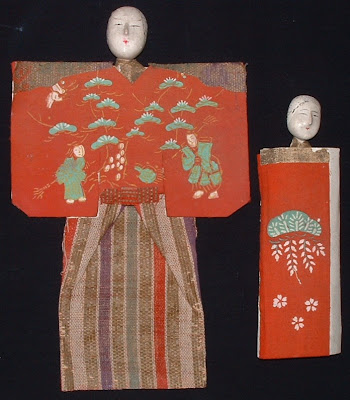Hina-matsuri in its present form only developed in the Edo period (1600-1868). This display is a typical 15 doll set. At the top are the Lord and Lady of the court, then three ladies in waiting, five musicians, the Minister of the Left and the Minister of the Right, three footmen and the Lady's household items.
The traditions and meanings associated with Hina matsuri have changed over time. It's origins have been traced back to Chinese purification rites and in pre-Edo times it was a purification ceremony associated with the emperor in which dolls used throughout the year were set out to sea on little boats. There is a strong tradition in Japan of using dolls as talismans which absorb evil or illness and are then destroyed. Similarly in another ancient hina tradition paper dolls called nademono or 'rubbing things' were rubbed on the body to absorb evil and then destroyed.
Another form of hina doll called tachibina or 'standing hina' evolved from the nademono. These were also originally made from paper and later fabric. They were popular by at least the early 16th century when there were specialist makers in Kyoto. Tachibina were placed on trays of offerings during the festival to attract kami (Shinto gods) into the house where they would inhabit the dolls and offer protection and purification. Here are some tachibina from my collection which we also displayed as part of our celebrations. These probably date from the 19th - early 20th century:
For more information on various Hina dolls and traditions have a look at Alan Scott Pate's 'Ningyo: The Art of the Japanese Doll' (Tuttle, 2005).















